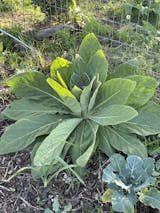Growing Borage from Seed to Harvest Posted on 13 Jan 04:01 , 9 comments
January is Plant for Pollinators month at Mary's Heirloom Seeds so this how-to article is just in time! Borage (Borago officinalis) is an amazing plant to grow in your garden to attract pollinators.
Borage plants can grow up to three feet tall, producing gorgeous blooms.
The flavor of Borage is similar to a cucumber. Borage has bright blue, star-shaped flowers that explode in a blue profusion all summer attracting honey bees. The flowers and young leaves may be used to garnish salads, dips and cucumber soups.
Borage is also a companion plant for Tomatoes, Peppers, Squash, Strawberries and more.
Growing Borage from Seed
Borage is a hardy annual, which means that the plant will die in a frost . A word of caution, if you let Borage mature to produce seeds, you will have LOTS of borage next year.
Borage plants produce the most flowers in full sun, but they can also tolerate partial shade. Choose a planting area that gets at least six hours of sunlight per day for best results.
Sow seeds 1/2 in deep in moist, well draining soil. Water regularly so the area does not dry out.
If you have a container garden, Borage should be planted in a container that is 12 inches deep or more.
This hardy plant can thrive in hot and cool weather so it's prefect for just about every garden zone.
Companion Planting with Borage
Companion plant. Companion planting borage next to strawberries and tomatoes can increase their fruit yield, while also fending off tomato hornworms. Borage attracts beneficial insects, pollinators like honeybees, bumblebees, and butterflies, while also serving as a deterrent to cabbage moths.
Complete COMPANION PLANTING GUIDE
Harvesting Borage
As we mentioned early, Borage can easily go to seed and "pop up" next year in your garden. Remove flower heads towards the end of their lifecycle to prevent self-seeding.
Both the flowers and the leaves are edible. Smaller leaves are my favorite as the larger leaves can be prickly.
The gorgeous flowers make an excellent garnish for baked good and savory dishes.
If you end up with LOTS of Borage, you can feed some to livestock or even make a fertilizer tea. Yes, that's a 5 gallon bucket of borage leaves! Our chickens love it!
I use scissors to clip off flowers and leaves. It's easy to collect them in a bowl or bucket. The larger leaves can be prickly so it would be a good idea to wear gloves when working with Borage.
Read more at Gardening Know How: Borage Seed Growing – How To Plant













Comments
Dennis Gliebe on
I want to grow borage in Sacramento Ca. What is your suggestion. It i now 1/22/2024
Janet on
I wish I could download information or Beatles to pin to read later. Thanks
Wendy on
Can I winter sow borage?
Abby on
If I wanted to start this indoors then transplant, how many weeks before my last frost can I plant it? Does one plant last a whole season? Or would I succession plant it?
Tiffany on
Thank you for this. Always been a little nervous to try borage here in Florida. What time of year to you recommend planting here?
Teri S on
I grew borage in my greenhouse last winter. It survived the whole winter but did not bloom until spring (March) when temperatures started warm up. I moved it outside in early April (zone 7) and because it was the only thing blooming it was literally covered with bees, bumblebees and butterflies. Such a joy so early in the spring! I did eat some of the blossoms. They are sweet with the after taste of a mild cucumber.
Rae Lozano on
I will have to try this in my garden this year.
Denise Acevedo on
I wish I could filter by what would grow in my zone.
Thanks!
Janet LeSollen on
GArdening is good for my soul